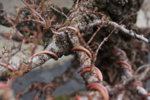bwaynef
Masterpiece
I noticed something like that on my (much smaller) corkbark elm. Any idea what indicators are for that time of year, @cmeg1? Looks like Peach Leaf Curl is Taphrina deformans. See below for a few fungicides that list either of those. On peaches, looks like infection occurs w/in 2 weeks of budding out. Treatment is in fall or whenever they go dormant w/ a fungicide applied to the point of dripping off. I saw one article that mentioned some people in certain climates report (some) success w/ Spring as well as Fall fungicide applications. (With this information, I'm going to hit mine w/ Daconil soon and in the Fall.)
$ grep -i curl *
bacillus-amyloliquefaciens.txt each Leaf Curl
each Leaf Curl
$ grep -i taphrina *
bacillus-amyloliquefaciens.txt:Taphrina
biophospro.txt:Taphrina
biophospro.txt~:Taphrina
chlorothalanil.txt:Taphrina Blister
daconil.txt:Taphrina Blister
I also see Copper & Bordeaux mixture listed for treatment.
$ grep -i curl *
bacillus-amyloliquefaciens.txt
$ grep -i taphrina *
bacillus-amyloliquefaciens.txt:Taphrina
biophospro.txt:Taphrina
biophospro.txt~:Taphrina
chlorothalanil.txt:Taphrina Blister
daconil.txt:Taphrina Blister
I also see Copper & Bordeaux mixture listed for treatment.









